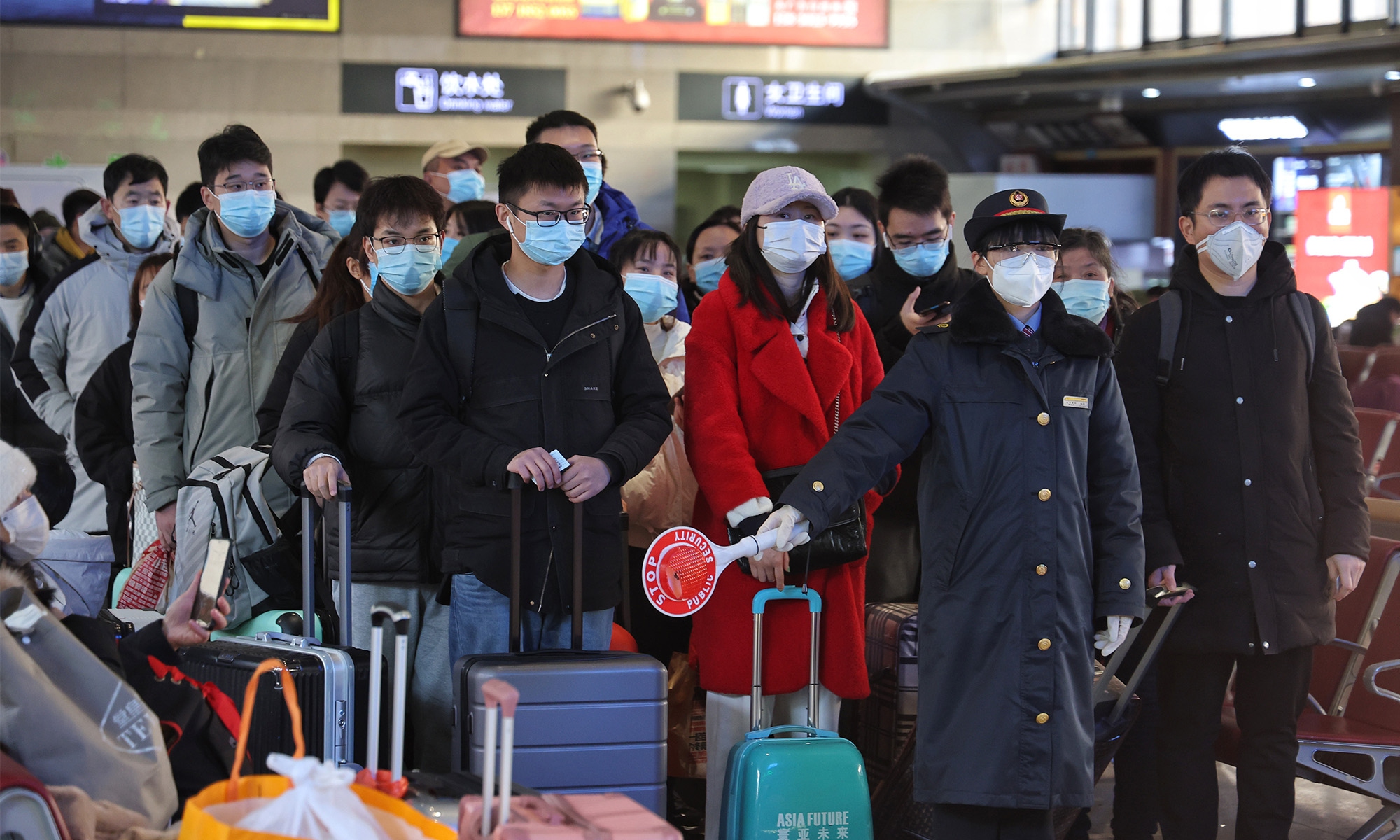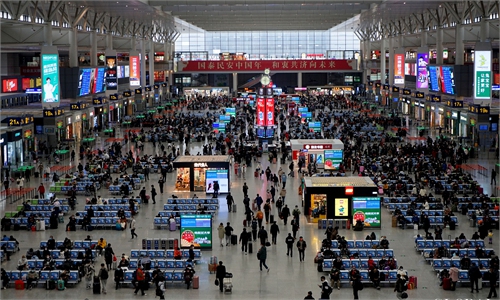
Photo:Li Hao/GT
China's 40-day Chunyun or Spring Festival travel rush, the world's largest human migration, kicked off on Monday with cautious measures amid domestic COVID-19 flare-ups in at least 10 provinces and regions.
As the first train pulled out of Beijing West Railway Station at 5:34 am on Monday, the capital city officially entered the Chunyun time. At the station, a Global Times reporter saw passengers, mainly students and migrant workers, taking their luggage and entering the station in an orderly way, waiting for trains to take them home.
Flows of passengers on the first day of Chunyun were also quite steady in train stations around other Chinese cities, with no long queues, according to media reports. China Railway Shanghai Group previously predicted that the week ahead of the Spring Festival and the week after the Lantern Festival could see more concentrated passenger flows.
Affected by domestic outbreaks, trains to and from affected regions have been suspended or reduced. Many people chose to stay put to celebrate their holidays, and some cities gave extra bonuses to those who opted to stay.
Beijing West Railway Station will handle 3 million passengers during the entire Chunyun, a daily average of 75,000. The three major railway stations in Shanghai were expected to see about 174,000 trips on the first day of Chunyun, the Global Times learned on Monday.
Epidemic prevention is still the keyword of this Chunyun. Health codes and masks are essential for taking the public transportation system.
A Global Times reporter saw workers in the Beijing West Railway Station strengthen disinfection frequency, including the air conditioning system and indoor waiting rooms. Five disinfection robots were deployed at the main corridor of the station.
At Shanghai's Hongqiao Railway Station, a Global Times reporter saw workers holding signs to remind passengers to wear their masks properly throughout their trips and keep a safe social distance.
Monday was also the first day that people could purchase rail tickets for Lunar New Year's Eve. Scenes of people vying for tickets as in previous years were rare this time and data from Qunar.com, a Chinese online travel agency, showed seats for trains to popular destinations were easily available on Monday.
An estimated 24.89 million trips were made nationwide on Monday, according to the Ministry of Transport.
A total of 280 million railway passenger trips are expected during the travel rush, of which the railway system in Beijing is expected to see 8.98 million trips, and about 9.1 million trips were expected to be made in Shanghai railway stations, according to the transportation departments.
The Civil Aviation Administration of China (CAAC) said nearly 600,000 passenger flights during the Chunyun period were scheduled, and some 20,000 extra flights were approved to be arranged as well. The country will see about 35 million trips by air, on par with last year's number.
More than 1.18 billion trips are expected to be made countrywide during the 40-day travel rush, a year-on-year increase of 35.6 percent. However, due to the ongoing risk of COVID-19 outbreaks, great uncertainties exist for this year's Chunyun.
If an outbreak occurs, railway services would be immediately suspended or reduced, and flights would also be adjusted dynamically in response, according to the latest anti-epidemic policy.
Wang Guangfa, a respiratory expert at Peking University First Hospital, told the Global Times that this year's Spring Festival travel rush comes amid sporadic outbreaks, similar to last year. The huge flow of passengers would certainly increase the risk of COVID-19 spreading, but the chances of a large-scale or uncontrollable outbreak are low, as anti-epidemic measures are top priority.
Geng Jin, 37, who's originally from Northwest China's Shaanxi Province, was interviewed by the Global Times at Beijing West Railway Station as he waited for a train. He said he felt that the situation in his hometown Xianyang is steady, so he decided to go home to reunite with his family.
"Last Spring Festival I did not return back home because my work was affected seriously by the epidemic and I didn't earn much. But in 2021, my business got better and I earned some money, so I will go back to share my happiness with my family," Geng said.
Affected by the domestic COVID-19 flare-ups, many people couldn't manage to get back home and decided to stay put.
Currently, 10 provinces and regions in China are registering COVID-19 infections, and eight regions in six provinces have detected the highly contagious Omicron variant.
Wang said that the outbreaks vary among regions. It's good to see the policy of encouraging people to stay put is not a one-size-fits-all approach.
Municipalities like Beijing and Tianjin, and provinces like Central China's Henan, East China's Jiangsu and North China's Inner Mongolia Autonomous Region, have called on local residents to stay put during the holidays. Many cities said they will offer some cash or coupons for migrant workers.
Anhui Province's Hefei will reward each migrant worker who works during the holiday with 1,000 yuan ($157) as a bonus. Anhui's Wuhu will give migrant workers 200 yuan.
The local government in Wenzhou in Zhejiang Province will pay bonuses to enterprises that keep 50 employees or 100 employees on the job with amounts of 50,000 yuan and 100,000 yuan, respectively.
Yiwu, one of the world's largest small commodity trading hubs in East China's Zhejiang Province, will make all parking lots, buses and A-level scenic spots free during the holidays.





